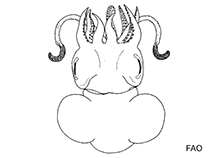Euprymna hoylei Adam, 1986
Изображение на Google | No image available for this species;
drawing shows typical species in Sepiolidae.
Классификация / Names народные названия | синонимы | CoL | ITIS | WoRMS
Cephalopoda | Sepiida | Sepiolidae | Sepiolinae
Environment: milieu / climate zone / пределы глубины / distribution range экология
демерсальный. Tropical; 10°S - 44°S, 112°E - 154°E
Distribution страны | регионы FAO | Ecosystems | места находок | интродукции
Indo-West Pacific: Australia and Philippines.
Length at first maturity / Size / Weight / Возраст
половая зрелость: Lm ? range ? - ? cm
Life cycle and mating behavior половая зрелость | размножение | нерест | Eggs | Fecundity | Larvae
Основная ссылка
ссылки | координатор | соавторы
Jereb, P. and C.F.E. Roper (eds.) 2005 Cephalopods of the world. An Annotated and Illustrated catalogue of Cephalopod species known to date. Vol. 1. Chambered nautiluses and sepioids (Nautilidae, Sepiidae, Sepiolidae, Sepiadariidae, Idiosepiidae and Spirulidae). FAO Spec. Cat. Fish. Purp. 4(1):262p. Rome: FAO. (ссылка 1695)
Статус Красного Списка МСОП
(ссылка 130435: Version 2025-1)
Статус СИТЕС (ссылка 108899)
CMS (ссылка 116361)
Угроза для людей
Использование человеком
| FishSource |
инструменты
дополнительная информация
состав пищи
потребление пищи
хищники
Max. ages / sizes
Length-weight rel.
Length-length rel.
Размерный состав
Mass conversion
численность
ресурсы в Интернет
BHL | BOLD Systems | CISTI | DiscoverLife | FAO(Publication : search) | Fishipedia | GenBank (Геном, Нуклеотид) | GloBI | Gomexsi | Google Books | Google Scholar | Google | PubMed | Tree of Life | Wikipedia (Вперёд, поиск) | Zoological Record



